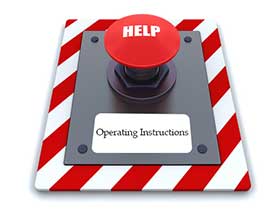From the Editor: Summer gives us an opportunity to revisit some of our popular posts, and you can check into something you might have missed. Our final summer replay is from Dan Goldstein, and and first appeared on September 16, 2014. For anyone who thinks tech writers just do manuals, it’s worth reading about the other “fun” stuff they handle, and why it’s important.
You probably think that labels are p ieces of paper that we glue to things to identify them. Fortunately, the fun-loving Food and Drug Administration has a much more adventurous definition than that. Tech writers who work in medical devices have a whole world of “labeling” to navigate.
ieces of paper that we glue to things to identify them. Fortunately, the fun-loving Food and Drug Administration has a much more adventurous definition than that. Tech writers who work in medical devices have a whole world of “labeling” to navigate.
Sometimes, when law is interpreted, it gets broadened. Take, for example, the plain-language Biblical prohibition against boiling a baby goat in its mother’s milk. Subsequent dietary law expanded “baby goat” to all forms of meat (excluding fish, but never mind that now) and “mother’s milk” to all forms of dairy. As a result, there is no such thing as kosher chicken alfredo.
Likewise, in the plain-language Food, Drug, and Cosmetics Act, “labeling” in the law includes anything written on a medical device or its packaging, or “accompanying” it. But as the FDA’s manual drily notes, “The term ‘accompanied’ is interpreted liberally.” In FDA-Land, “labeling” doesn’t just mean that little sticker. It means everything that the manufacturer has ever said about the device, including advertising, promotional coffee mugs, and (wake up, tech writers!) user manuals.
So there’s the label, and then there’s labeling. (As I often tell my kids, “-ing” is the crucial difference between “bald” and “balding.”) There’s actually some logic to this. For example, a safety label on the device might read, “Do not push the red button.” The user manual might then explain in detail the risks involved in pushing the red button, what to do if it gets pushed by accident, and so on. But if the company then hands out brochures that read, “Just push the red button and your pimples disappear like magic!” – well, that’s as bad as leaving the word “not” off the little label.
Part of the fun of writing in this environment is this extra layer of requirements. As in all tech writing, you have to know how the thing actually works, what can go wrong, what information the user gets from the device, and much more. But you also have to consider what the FDA allows the manufacturer to claim about the device’s Power To Heal. And while you’re at it, keep a friendly eye on your colleagues over in MarComm, because what they produce isn’t “just advertising”: It’s all labeling, kids, and the FDA will scrutinize it as minutely as your own manuals and the little stickers on the side.